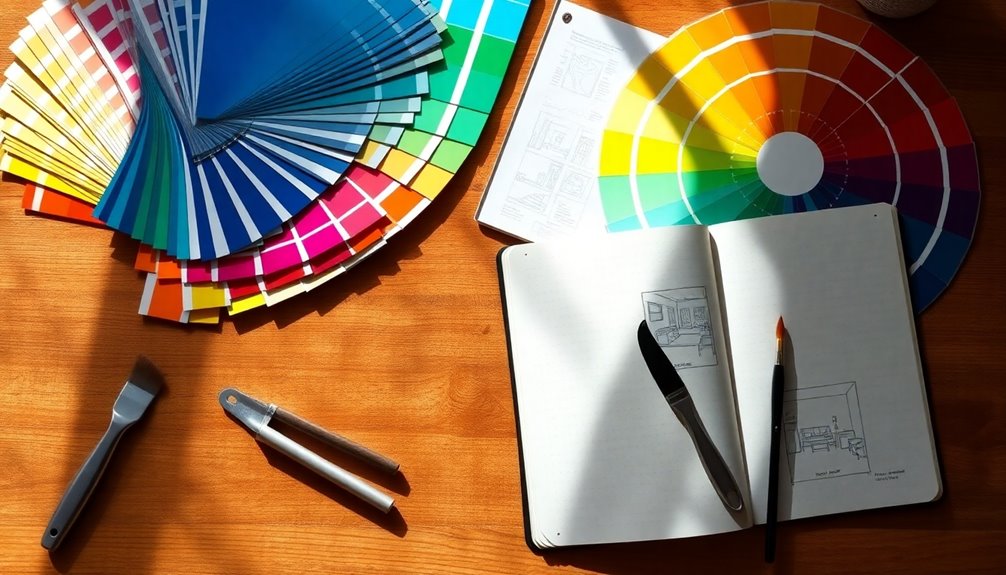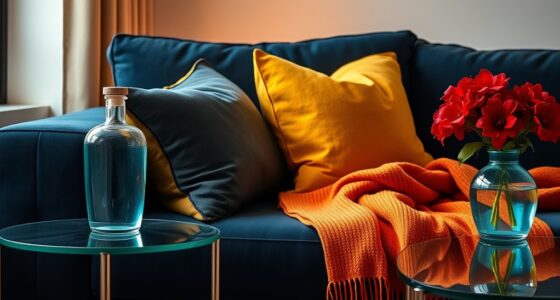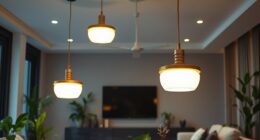To create a color combination chart for your home, start by understanding color theory and choosing a versatile base color. Use online tools like Coolors.co or Adobe Color to generate harmonious palettes and visualize tints and shades. Organize your colors into dominant, secondary, and accent sections, applying the 60-30-10 rule for balance. Test colors in different lighting to guarantee cohesion. Keep exploring the ways you can fine-tune your palette for a more inviting space.
Key Takeaways
- Utilize online palette generators like Coolors.co to experiment with color combinations and visualize your choices effectively.
- Create a color chart categorizing colors into dominant, secondary, and accent sections for easy reference and organization.
- Test color combinations in different lighting conditions to ensure they harmonize with your existing furnishings and space.
- Implement the 60-30-10 rule to maintain balanced color distribution across your home decor and furnishings.
- Keep a digital or physical collection of swatches to visualize real colors in your space and make informed decisions.
Understanding Color Theory Basics
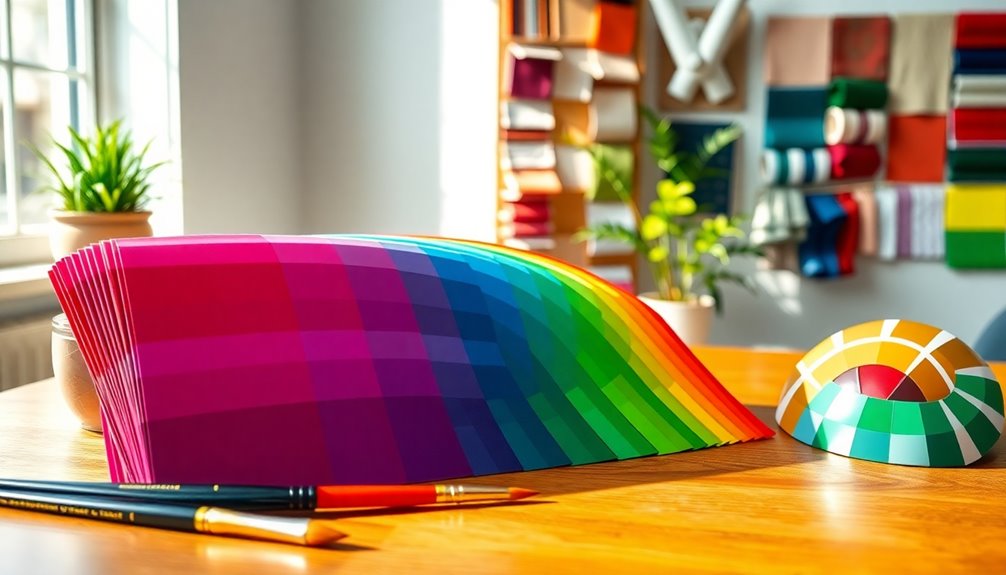
When you immerse yourself in color theory, you'll discover it's all about understanding how colors interact and affect your space.
You'll learn about hues—the building blocks of color—divided into primary, secondary, and tertiary categories. By experimenting with tints, tones, and shades, you'll create a diverse palette.
Warm colors like reds and oranges energize a room, while cool colors such as blues and greens bring serenity.
Understanding color schemes is essential; complementary colors can create vibrant contrasts, while analogous colors provide harmony.
By applying these concepts, you can evoke specific moods and enhance your home's atmosphere.
Mastering these basics of color theory will empower you to make informed design choices that resonate with your personal style.
Choosing Your Base Color
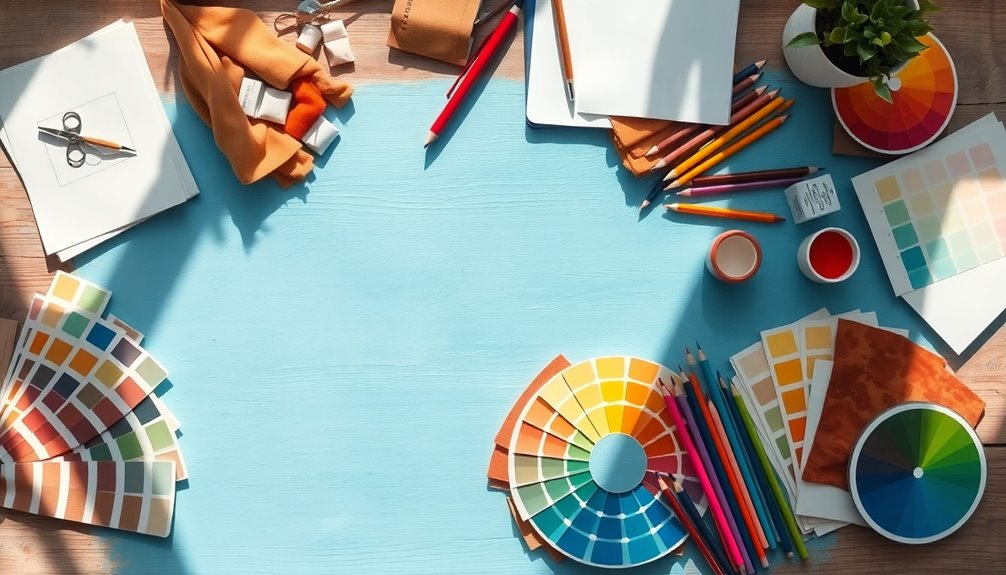
Choosing a base color sets the stage for your entire color palette, so it's important to select one that resonates with your vision for the space. Aim for hues that aren't overly dark or saturated, ensuring versatility in your color combinations.
Using a color wheel tool can help you identify highlighted areas for a strong foundation. Give your base color a personal name to deepen your connection and make the development process more meaningful.
Remember, the chosen base color greatly influences the mood of your palette, so consider the atmosphere you want to create. Additionally, incorporating a neutral color palette can enhance the overall warmth and inviting feel of your space.
Finally, experiment with color by testing your base in different lighting conditions, as colors can shift throughout the day, affecting your final choice.
Creating Tints and Shades

To create a stunning color palette, visualize the relationship between tints and shades by imagining an arc—moving left for lighter tints and right for deeper shades.
Incorporating a mix of these variations not only enhances the richness of your palette but also keeps your combinations dynamic and engaging.
Experiment with different saturations to strike a balance that makes your space feel cohesive and vibrant.
Visualizing Color Relationships
Visualizing color relationships can transform your home design, allowing you to create a harmonious and inviting space.
Start by selecting a base color and experiment with creating color by adding white for tints or black for shades. This process generates a richer color palette that enhances visual interest and avoids monotony.
As you move along the arc, explore complementary tints and shades, adjusting hue, saturation, and lightness to find the perfect balance.
Introducing new hues while maintaining the integrity of your palette can wrap around the color wheel, fostering an analogous color harmony.
Dynamic Color Pairings
As you explore dynamic color pairings, understanding the interplay between tints and shades can elevate your design choices.
Here's how to create a color palette that pops:
- Visualize the Spectrum: Use an arc to represent tints (lighter) on the left and shades (darker) on the right.
- Mix for Variety: Combine your base color with white for tints and black for shades to achieve depth and avoid monotony.
- Create Harmony: Introduce new hues to form analogous colors that work well together, adding interest and continuity.
Enhancing Palette Richness
When you plunge into creating tints and shades, you'll discover how they can considerably enhance the richness of your color palette.
Start with a base color and use a color palette generator to visualize its relationship. Move left for tints by adding white, and right for shades by adding black. Brighter tints have less saturation, while darker shades offer more, allowing for dynamic color pairings.
To avoid monotony, incorporate a variety of tints and shades from your base color. Introducing new hues can create harmonious color relationships and maintain visual interest.
Adjusting hue, saturation, and lightness will help you finalize a vibrant palette, ensuring a balanced mix of contrasting and neutral tones that truly enhance richness. Additionally, understanding color accuracy is essential for achieving the best visual experience in your projects.
Exploring Color Combinations

Understanding color combinations can transform your home's atmosphere, making it feel inviting and cohesive.
To effectively explore color schemes, consider these tips:
- Utilize different color schemes: Try analogous, complementary, or monochromatic palettes to establish harmony.
- Apply the 60-30-10 rule: Balance your colors by using 60% dominant, 30% secondary, and 10% accent colors for visual interest.
- Experiment with paint swatches: Test colors in various lighting conditions to guarantee they achieve your desired effect.
Tools for Generating Color Palettes

When you're ready to create the perfect color palette for your home, online tools and mobile apps can be your best friends.
These resources let you experiment with colors, visualize your choices, and even generate palettes from your favorite images.
With just a few clicks, you can find the ideal combination that brings your vision to life.
Online Palette Generators
How can you effortlessly create the perfect color palette for your home? Online palette generators are your best bet. Here are three fantastic options to explore:
- Coolors.co – Quickly generates harmonious combinations based on your chosen base color.
- Sherwin-Williams' ColorSnap – Upload a photo and let it create a palette that fits your space.
- Color Designer – Use the interactive color picker to experiment with tints and shades.
These tools are user-friendly and often offer free color options. You can easily save your palettes for future reference, helping you choose colors that enhance your design projects.
Plus, many generators include features for adjusting saturation and even viewing palettes in color blindness modes, ensuring everyone can find the perfect match.
Mobile Color Apps
Mobile color apps make it easy to generate stunning color palettes right from your smartphone. These tools help you find the best combinations for any room. For instance, Sherwin-Williams' ColorSnap lets you upload photos and create a perfect color palette that coordinates with their paints. Glidden Paints' Visualize Color app enables you to virtually paint your space, while Coolors.co offers palette generation from images with customizable features. Additionally, Adobe Color's web-based color wheel provides RGB values for precise matching, and Color Designer allows experimentation with tints and shades.
| App Name | Key Feature | Best For |
|---|---|---|
| ColorSnap | Upload photos for palettes | Coordinating paint options |
| Visualize Color | Virtually paint rooms | Tailored palette creation |
| Coolors.co | Generate from images | Adjusting color accessibility |
Organizing Your Color Chart

To effectively organize your color chart, start by choosing a base color that reflects your personal style and the atmosphere you want to create in your home. This base color will anchor your choices.
Here's how to proceed:
- Utilize digital tools: Use apps like ColorSnap or Adobe Color to visualize combinations easily.
- Create a structured chart: Organize your colors into sections, including your base color, tints, shades, and additional hues categorized by use, like wall paint or furnishings.
- Apply the 60-30-10 rule: Keep track of color proportions, ensuring the dominant color fills 60% of the space, secondary color 30%, and accent color 10%.
Regularly update your color chart with swatches to maintain your desired aesthetic throughout different lighting conditions.
Incorporating Color Psychology

Embracing the power of color psychology can transform the atmosphere of your home and influence your mood. To create a harmonious space, find three colors that resonate with your feelings and the purpose of each room.
For instance, warm colors like reds and oranges can energize your living room, while cool colors like blues and greens promote relaxation in bedrooms. You might also consider high contrast combinations—like a neutral backdrop with vibrant accents—to enhance the emotional impact of your design.
Practical Applications of Your Color Palette
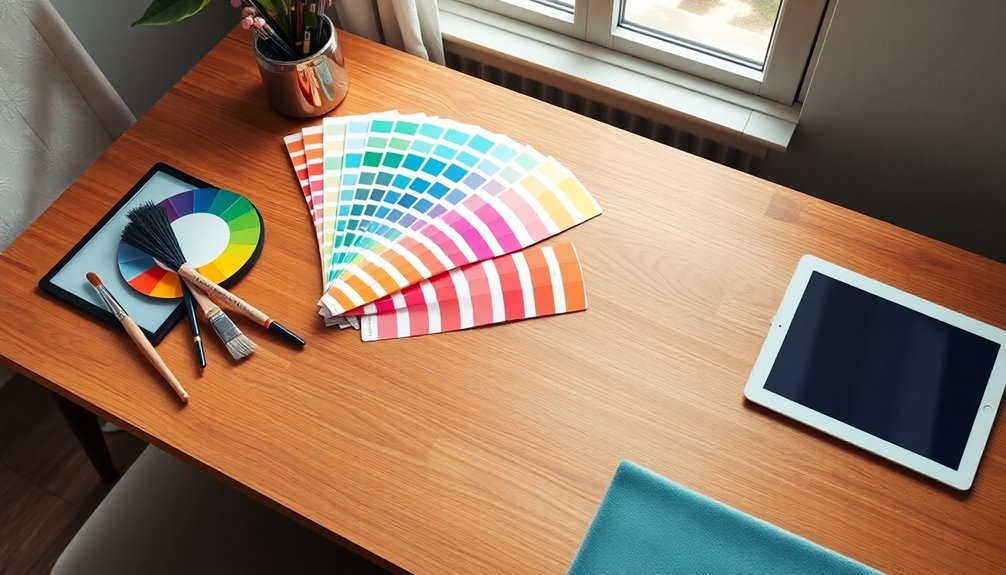
While choosing a color palette is essential, knowing how to apply it practically in your home design can make all the difference. Here are three effective ways to utilize your color choices:
- Apply the 60-30-10 Rule: Use 60% of your dominant color for walls, 30% for secondary colors in larger furniture, and 10% for accent colors like throw pillows.
- Create a Color Chart: Organize your colors into sections—dominant, secondary, and accent—to visualize their relationships easily.
- Utilize Digital Tools: Use platforms like Adobe Color or Coolors.co to save and adjust your palette, ensuring you always have access to your great color combinations.
Tips for Maintaining Color Harmony
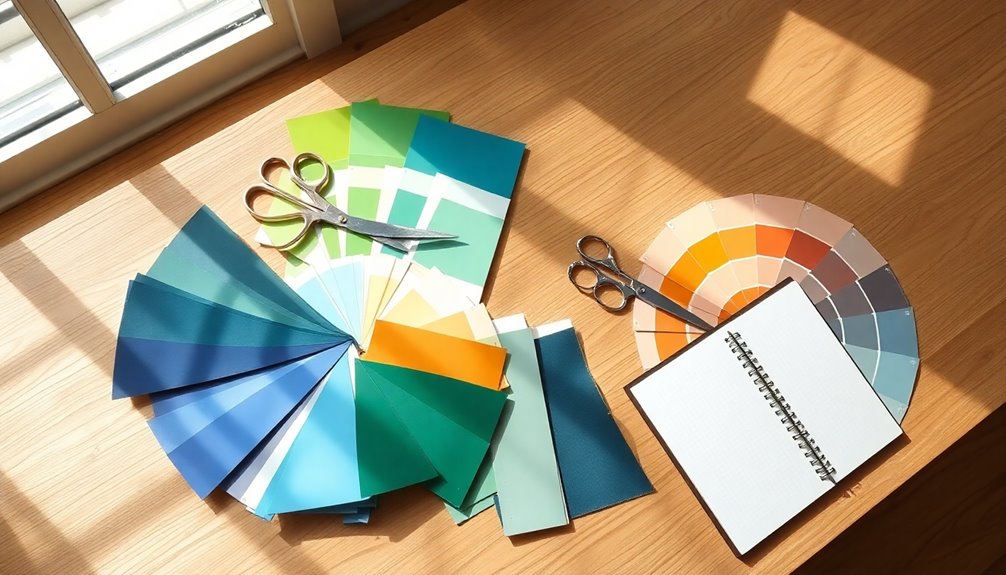
Implementing a well-considered color palette is just the start; maintaining color harmony throughout your home guarantees a cohesive and inviting atmosphere.
To achieve this, consider using a monochromatic color scheme or one color with various shades, making sure your space feels integrated. Follow the 60-30-10 rule to proportion dominant, secondary, and accent colors effectively, creating balance.
Regularly review your color combination chart against existing furnishings and architectural elements to avoid clashing tones. Additionally, test your colors in different lighting conditions to confirm they maintain harmony throughout the day and under artificial light.
Frequently Asked Questions
How to Figure Out What Colors Go Together?
To figure out what colors go together, start by choosing a base color that reflects your desired mood.
Use color theory, focusing on complementary and analogous colors from the color wheel, to find harmonious pairs.
Experiment with different tints and shades to add depth.
Don't forget to incorporate neutral tones for balance.
Finally, test your combinations in various lighting and against your existing decor to verify they work well together.
How to Create a Color Palette for Your Home?
Imagine walking into a space that feels like a warm embrace.
To create a color palette for your home, start by picking a base color that sets the mood. Then, explore the color wheel to craft tints and shades, adding depth to your selection.
Introduce complementary hues for harmony, and mix in neutrals for balance.
Finally, use tools like Adobe Color to visualize your choices and refine your perfect palette effortlessly.
What Is the 60 30 10 Color Rule?
The 60-30-10 color rule helps you create a balanced color scheme in your space.
You'll use 60% of the dominant color for your walls, which usually includes neutral shades.
Then, allocate 30% for secondary elements like furniture, adding depth.
Finally, reserve 10% for accent colors that pop and draw attention to specific features.
What Is the 3 Color Palette Rule?
Imagine you're redesigning your living room. The 3 Color Palette Rule can simplify your choices.
You'll choose a dominant color for the walls—let's say a calming blue, which takes up 60% of your space.
Next, select a soft gray for your sofa, making up 30%.
Finally, add a vibrant yellow in pillows or artwork, which serves as your 10% accent.
This approach keeps your design cohesive and visually pleasing without overwhelming the space.
Conclusion
By understanding color theory, choosing your base color, and exploring combinations, you can create a vibrant color chart that transforms your home. With the right tools, effective organization, and a touch of color psychology, you'll bring harmony to your space. So, embrace creativity, enjoy the process, and watch your vision come to life. Remember, it's not just about colors; it's about creating an atmosphere that reflects your style and enhances your well-being.
